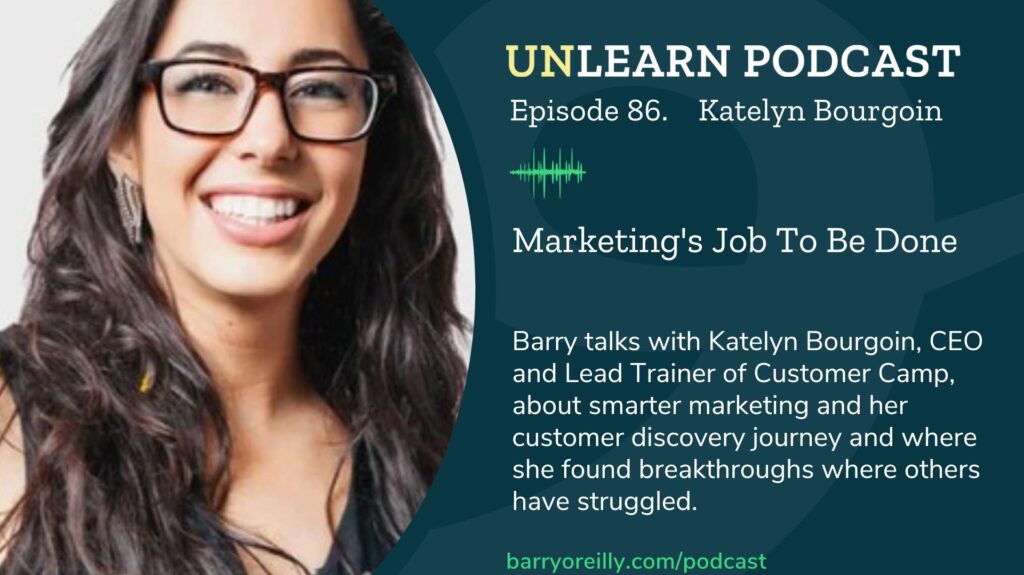Katelyn Bourgoin is a marketer by trade and founder by choice. She is CEO and Lead Trainer of Customer Camp, where she helps teams make smarter marketing decisions with buyer psychology. A marketing powerhouse, Katelyn has been nicknamed “The Customer Whisperer,” and called an “influential entrepreneur” by Forbes; she is also one of the Top 20 Wonder Women of SaaS Marketing and Growth. In this episode of Unlearn, she and Barry O’Reilly discuss marketing’s job to be done, her customer discovery journey and where she found breakthroughs where others have struggled.
Effective Customer Discovery
After a brief, failed venture into making a tech company, Katelyn discovered something about customer discovery she previously misunderstood. She knew the importance of understanding and targeting your audience, but was left stumped when she did things as she was supposed to and achieved poor results. She underestimated the true value of market research, and tried selling a solution at the start, instead of starting with the customers’ needs and working backwards to the solution. When she learned this lesson, she gave entrepreneurship another go by doing marketing consulting. It was in discussions with clients that she realized this issue was prevalent throughout many industries: companies did not know their customers. [Listen from 2:45]

Job to be Done (JTBD)
Your ideal customer profile shouldn’t be based solely on demographics, but on the job your customers need your product or service to help them perform. Katelyn learned the Jobs-to-be-Done (JTBD) philosophy at a webinar by Forget the Funnel and it has influenced her approach to marketing ever since. Essentially, JTBD posits that people hire products and services to help them get a job done. They will continue to use that product for as long as it fulfills their needs and circumstances, and helps them move closer to where and who they want to be. “People don’t buy products and services willy-nilly,” Katelyn explains. “…We actually have a job we’re trying to get done.” Once that solution stops working, they will find a new one. “When you understand innovation this way you start to see that it’s analyzing the job not the customer specifically that helps you to [market] better… it’s because they have a specific job to do and they have a particular context in which your solution is the best, and that’s why they’re the best customer,” she points out. Barry agrees that marketers should first know what their customers need, and work backwards from there. Companies who create solutions to problems tend to survive longer because they understand their customers’ needs. [Listen from 9:30]
(Listen to Design For The Web 3.0 Economy with James Sommerville)
The Buyer Journey Interview
Integrating JTBD into buyer journey interviews -also called switch interviews – is the next step in elevating your market research. Katelyn’s mentor Bob Moesta was the one to make this discovery, and it happened by accident. Due to his dyslexia, Bob would draw a timeline of his clients’ stories instead of jotting down notes since this visual method was more effective for him. While drawing these images, it hit him like a brick: customer researchers were doing interviews all wrong. They had a siloed approach to solving customer problems, focusing on a specific issue under specific circumstances rather than getting the full picture of what led a customer to them in the first place. Using the latter method gives you much more information about what triggers a customer’s buying habits. Katelyn tells Barry, “For me jobs-to-be-done is all about understanding customers and understanding what triggers them to begin that buying journey.” [Listen from 14:50]
(Listen to Exits and Acquisitions with Shawn Flynn)
Katelyn created the Trigger technique to extract four pieces of information: what triggers customers to begin their buying journey, what job they’re trying to get done, what their pains are with other solutions, and what their selfish desires are. She turns this information into smart campaigns. [Listen from 18:35]
Barry shares his own introduction to switch interviews and how it transformed his business. He remarks, “All of these techniques really were a huge breakthrough for me personally about understanding myself what I like to do, what I wanted to do, how I could talk to people about the things I like to do in a way that resonated with problems that they had or things that they were interested in solving.” Using switch interviews was a filter mechanism that brought customers who were “on my vibe”, Barry comments. [Listen from 19:50]
Who Are Your True Competitors?
Katelyn talks about April Dunford’s exercise to understand who your real competitors are, and what the real job to be done is. If your product didn’t exist, what alternative solutions would people use? What are they using right now, if not your direct competitor’s products? Getting into the layers of who your real competition is and deeply understanding the job being done helps you see your solution in an innovative way, Katelyn shares. ConvertKit is one company that is successful at this: they don’t see themselves as email marketing software, but as a platform that helps creators make a living creating. Their concierge service and their recent sponsor network program demonstrate their mission, and sets them apart from other email service providers. Solving creators’ problem of how to make a living opens up many opportunities for them and customers love them for it. [Listen from 25:00]
Looking Ahead
In following her dream scenario of building a scalable business that doesn’t require too much of her time, Katelyn is building out her newsletter, Why We Buy, into a media company. She has halted her consulting work to focus on this new venture, which she is doing with an amazing team of contractors as opposed to individual employees. [Listen from 32:35]















